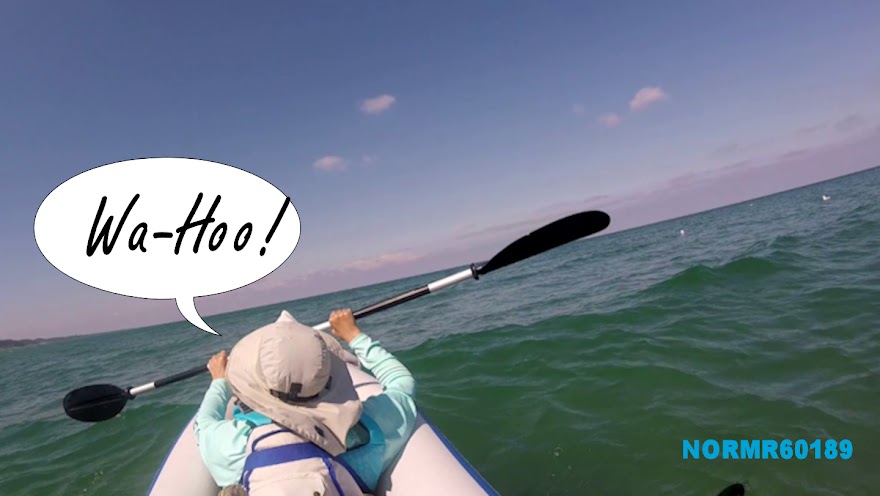
 |
| Dawn in the rest stop |
With the changing weather it was time to leave the Northland. We had two choices; go to the southeast, or to the southwest. We wanted to visit in the southeast, but this is holiday season and that can be stressful. Family, preparations, cooking, visitors and so on. We decided to delay the Southeast and head to the Southwest.
Before leaving we did want to spend some time with family and friends. Our attempt to stage a pre-Thanksgiving dinner of smoked, baked ham failed because of everyone's schedule. Instead we arranged for several meals at restaurants (our treat) because we would be away for the traditional Thanksgiving and Christmas holidays. These were small group dining experiences and provided for more intimate and comfortable discussions. One meal was at the Reel Club, where we treated G's aunt and her cousin. It was very enjoyable.
We discussed with friends to the east and we decided to delay our visit to the southeast until spring. So to the southwest it is to be. I packed and decided there wasn't enough room for G. So I set out alone and she will catch up via air.
As to be expected for this time of year, the weather was changing. I packed all day. The water system was empty to lighten the load. I filled the lower storage area, the rear storage area and the external slide bay. Then I filled the rear. I stacked containers and boxes neatly, filled all the compartments and then piled the soft stuff toward the front. I even filled the bathroom with soft goods.
 |
| No room in the rear |
The full to the gills interior was expected and I planned to sleep in the front by rotating the front passenger seat and setting up a temporary bed; our Roadtrek is equipped with a folding mattress, which adds a sleeping area in the front, in addition to the king bed/dual twins in the rear.
I took off at 7:15pm. Five hours later I stopped at a rest stop, set up the bed in the front of the Roadtrek and quickly fell asleep. It had been a really long day. It was about 60F outside, but a weather front was coming and there was snow in the Dakotas. This pleasantry would not last.
The next morning I awoke at dawn.
 |
| Awake at dawn |
After brief preparation off I went. The day went smoothly until I entered western Missouri. At that time I encountered the front, with very strong wind gusts. I was driving west or southwest and so the gusts were head on at times or about 30 degrees off the starboard bow. As I travelled the gusts became worse and soon the wind noise was a roar. Semi's were fishtailing ahead. Now that a lot of wind. G called me to see how I was doing and she commented "What's that roar?" It was the sound of the wind. I think the combination of my forward speed of 65 MPH and the 35-40 MPH headwinds resulted in the equivalent of a 100 MPH wind. Mileage took a hit and I was averaging about 13.1-13.7 MPG. I could have slowed down, but I knew "a change is acoming" and I surmised any delay would put me in the middle of it. Temperatures were falling steadily. Driving was difficult and I had to keep both hands on the wheel at all times.
At a gas stop I checked the weather and it was going to be about 25F in Amarillo, TX that night. I decided to press on, as the temperatures would be even lower as I travelled further west. Amarillo is at 3605 feet above sea level. It was going to be a clear night, and calm.
I arrived at Amarillo at about 8:00pm. It was late and so I decided to stay at an RV friendly gas stop, which G had checked for me and it was also on Allstays. But I wouldn't have power. I decided against running the generator. Not that big a deal for me; I had a polartec blanket, etc. and this would be a real camping experience. I slept pretty well. My Class B doesn't have much insulation and with the large glass area that's the largest heat loss. But I took the third seat back, put it against the wall and slept against it. That's about 3 inches of insulation directly next to my "bed." I ran the engine to heat the interior, put on my winter jacket, pulled the blanket over me and fell asleep. I awoke once and thought "Gee, why is so warm?" I had the blanket over my head.
I awoke at 6:00 AM; it was about 25F. I walked to the McDonald's and got a breakfast with large coffee and left to eat it on the road.
The wind had moderated as the front had moved through. It was dark. As I travelled I could see a thin line of pink in the color rear view camera. It would be another long day.
I arrived at my destination at 3:43 PM (4:43 PM Central). I had travelled 1,805 miles, arriving about 45.5 hours after I began.
That's not my ideal for travel, but I had a destination to reach and G was arriving via air in a day and a half. Then we would begin our winter adventure. BTW, the Eclipse radio/DVD/CD is really great. But the TomTom GPS is not as accurate as I would like. I used a different GPS (Verizon with real time traffic and condition updates). However, when trekking I have the TomTom "on" but with no route planned.
Here is the display at the time of my arrival:
















